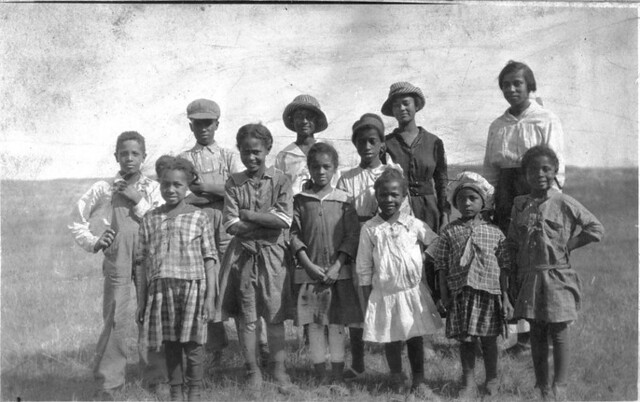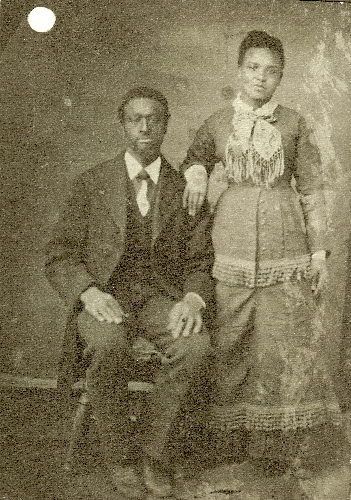
The Negro Comes to Nebraska.
From The Nebraska Memorial Library, "THE NEGROES OF NEBRASKA" -- (7) The development of the West, coincident with the disturbing economic upheavals in the South, attracted the attention of many of the dissatisfied freedmen. A new country was being opened up for settlement and frontiers were being pushed back. New lands, new surroundings, an opportunity for social and economic advancement, beckoned to the Negroes. In constantly increasing numbers they turned toward the North. By 1870 the first Negro exodus from the South was well under way.
Nebraska, with new industries springing up in the larger communities, attracted its share of the northward-bound Negro emigrants. Omaha especially became the point where the majority of them settled and established homes. There were jobs here for them, a chance to make a living. Those who came in advance of their families sent for them and brought them north.

The Shores family, near Westerville, Custer County, Nebraska, 1887. Jerry Shores was one of a number of former slaves to settle in Custer County. He took a claim adjacent to that of his brothers, Moses Speese and Henry Webb (each had taken the name of his former owner). (Nebraska Historical Society RG2608.PH-1231)
The news spread in the South. Friends and relatives, encouraged by reports of industrial opportunities and better educational advantages, joined the northward movement. The exodus was still further accelerated by a number of factors, both social and economic.
Under the system of share-cropping the Negro tenant farmer quickly found himself in difficulties. Unfavorable crop settlements, poor housing, and meager returns for his labor reduced his economic status to one approaching peonage. Floods and the ravages of the boll-weevil in the cotton fields added to his misery.
During the period of Reconstruction, under the northern "Carpet-Bag" rule, the whites of the South were forced to grant certain civil and political rights to the Negro. Bitterly resentful, the whites retaliated by the denial of voting privileges to Negroes, by rough treatment of them, and by heavy taxation. The Ku Klux Klan, the bush-whackers, and the "Padarohs" (dialect for "patrollers") spread terror among the ex-slaves. There was no recourse for them in unsympathetic courts.
In increasing numbers they became dissatisfied with conditions then existing in the South. By individuals and families and groups they swelled the flood of immigration until, by 1880, a constant tide of settlers was streaming into the northern states.
(8) It is not known just when Negroes first set foot on the land which now comprises the State of Nebraska. Legend has it that an exploring expedition headed by a monk, Fray Marcos, touched the south-eastern part of the State in 1539. A Negro servant is supposed to have been a member of the party. This same Negro is thought to have been with Coronado's expedition when he supposedly penetrated the southern part of Nebraska in 1541. The records of this expedition indicate that one or more Negroes were numbered among its members. Whether or not the Negro servant with Fray Marcos and a Negro with Coronado were the same individual is purely conjectural. In any event, if it be taken for granted that one or both of these expeditions crossed the present southern boundary of the State, then it is entirely possible that Negroes entered Nebraska as early as 1539 or 1541.

A Negro named York, a slave owned by Captain William Clark, was with the Lewis and Clark expedition on its journey through Nebraska in 1804. When Major Stephen H. Long's expedition entered Nebraska in 1819 Negroes, probably slaves, were found at a fur trading post in the vicinity of Fort Lisa. Several of the officers at Camp Missouri (1819) and later, at Fort Atkinson (1820-1827) owned Negro slaves, their personal servants, brought with them from some state south of Nebraska.
The oldest man in the State in 1894 was a full-blooded Negro, Baptiste, who lived on the Omaha reservation. He was then 112 years of age. He was captured many years before by the Indians near Bellevue, and was said to be the first Negro ever to cross the Missouri River into Nebraska.
In 1842 Tom Brown, the slave of a Missourian, accompanied his master to Nebraska on a buffalo hunt. He claimed to have visited the site of what is now Omaha, and stated that a few persons were dwelling there in Indian huts. Brown subsequently escaped from his master and fled into Canada. He returned to the United States after slavery was abolished and established a home in Grand Rapids, Michigan. He came back to Omaha in 1907 and remained there until his death at the age of ninety-five.

Among the very first of Omaha's settlers of either race was Sally Payne, who settled there in 1855. A blacksmith, Smith Coffey, came to Omaha about 1865. George Conway, Missouri-born ex-slave, came to Omaha in 1867. One of the few former slaves left in Nebraska, he lived in Omaha until his death in 1939. There were other Negroes occasionally settling there during the early years of Omaha's existence, but records with regard to them are fragmentary.
Sometime between 1865 and 1870 a Negro, Amos Harris, drifted into the Loup Valley region. He worked as a ranch-hand, finally as an independent rancher in Valley and Wheeler Counties, and became a respected citizen among his white neighbors. Another Negro ranch-hand was James Kelly, who came to Custer County in 1876, and lived there until his death in 1912.
The first Negro ever to settle in Lincoln came there in the summer of 1868. The first Negroes in Hastings were Mrs. Emma Stewart and her mother, who arrived there in 1877.

Robert Anderson, another ex-slave, homesteaded in Nebraska in 1870. He was one of the first, if not the first, Negro homesteaders in this State. His section of land in Box Butte County made him a wealthy man, one of the very few successful Negro farmers of Nebraska. The only other Negro homesteader of that time was L. B. Mattingly, who settled near David City shortly after the Civil War. David Patrick, the first Negro homesteader in Hamilton County, settled there, near Aurora, in 1873. For several years he carried mail by horseback to Fort Kearny. He and his (9) son, William, born in 1885, claim to be the only two Negroes ever to sit on a district court jury in Nebraska.
The names of several individuals appear, for one or another reason outstanding among the hundreds who migrated to Nebraska during the earlier years of the State's existence: John C. Elder, first Negro barber in Lincoln (1870); Josephine Mitchell, mother of the first colored child born in Lancaster County (1871); Mother Leeper, mother of William Leeper, the first Negro born in Omaha (1872); Josiah Waddle, first Negro barber in Nebraska City (1877); Graves, first Negro barber in Aurora (1878); Tom Cunningham, first Negro police officer in Lincoln (1880); Mason Todd, railroad porter in Lincoln (1879); Pete the Barber, who sold fruit at his barber shop in Niobrara (1879); Jenny Morgan, woman homesteader near Wellfleet (1883); Eliza Galloway, ex-slave, who came to Kearney in 1888, and lived there until her death in 1936, at the age of 100 years; July Miles, ex-slave, civil war veteran, who settled at Omaha in 1892; Jubilee Johnson, ex-slave, who died at Schuyler in 1894. [source: http://www.memoriallibrary.com/NE/Ethnic/Negro/nebraska.htm]


Hello,
ReplyDeleteI think you should also look at our website for additional information. Please click on the Nebraska site at the top of the page to see the nominations we've written on individuals of African descent that we've nominated to the Network to Freedom. Lewis Washington and Ruth Cox Adams, just to name a few, that should be mentioned here. There is still a lot of people to uncover, many more stories to tell. Please see our website below.
https://sites.google.com/a/apseagles.org/arlofreedomproject/home